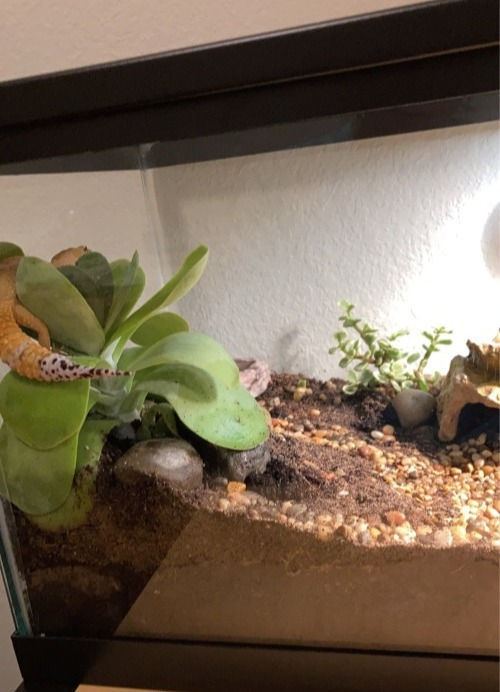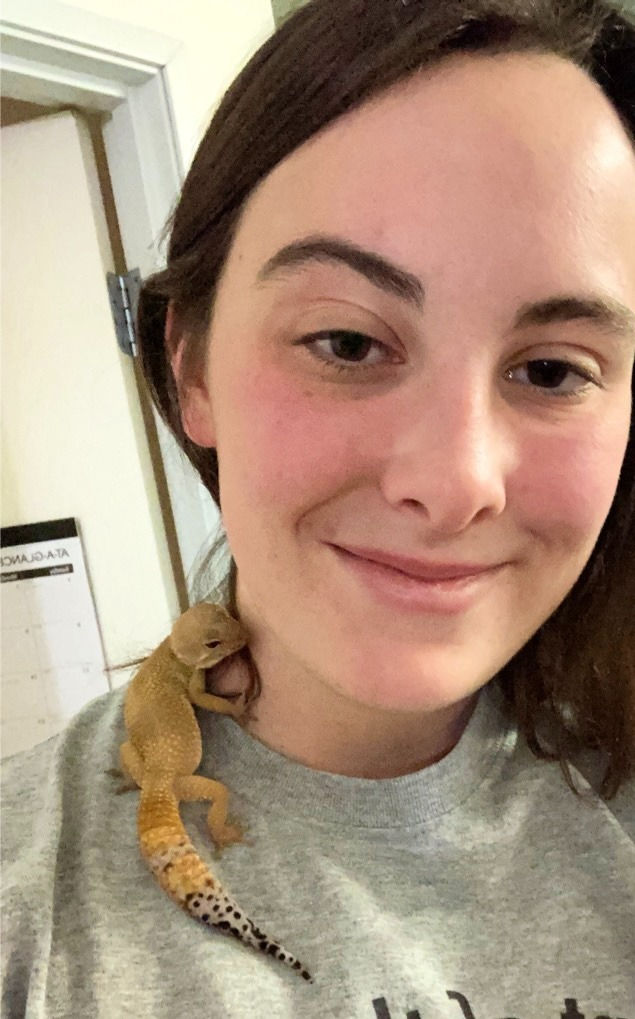
So you want a leopard gecko, but you're already at the roadblock of cost. Most pet stores charge you through the nose for starter kits, and you've only got $100, maybe $150 to spend, max. It might feel like you'll never have enough money for them. But contrary to popular belief, that starter kit is a waste of your time and money. You can DIY a leopard gecko terrarium setup for less than $150 all-inclusive, and you'll never have to size up your terrarium again. Want to know how? Read below!
DIY Reptile Terrarium for Under $150
Yep, you heard me right. It cost me less than $150 to set up a permanent home for my leopard gecko, Cleo. The photographic evidence is at the top right. It's got the proper lighting, substrate, hides, and decorations to support a healthy, happy leopard gecko. She thrives in a living environment that costs less than synthetic!
I've compiled a guide below of all the supplies and steps necessary to create this magical mountain home for your leopard gecko. Grab out some notes and prepare to build a terrarium for your pet to thrive in!
Ditch the Starter Kits
Before we get started, I need to address this common beginner's mistake. Most people get a leopard gecko as their first reptile, so being beginners, they tend to gravitate toward the "all-inclusive" starter kits. They think $100-$150 for these starter kits is reasonable, but they could not be more wrong.
The starter kits are far from all-inclusive. They come with the terrarium, a heat lamp & fixture, a terrarium lid, and maybe substrate if you're lucky. That leaves you with half the supplies missing! By the time you purchase a dry hide, wet hide, UVB lighting, a food dish, a water dish, food supplies, and decorations, you spend well over $250, sometimes upwards of $350. You haven't even gotten the gecko at this point!
Not to mention, these starter kits are always too small; most starter kits marketed for leopard geckos are only ten gallons, barely large enough for a juvenile gecko. You'll have to spend even more money to size up once your gecko grows to adult size.
Do not waste your money. Ditch the starter kit and try the method I've outlined below to save that hard-earned cash AND build a beautiful permanent terrarium you'll love.
Fish Tanks Work Exactly Like Terrariums for Half the Cost
Did you know that most terrariums are designed similarly, if not the exact same, as aquariums, but you're charged more for a terrarium than an aquarium? Sounds ridiculous, right? Well, it's real. I've seen some terrariums marked up to three times the cost of a fish tank of equal size.
Don't fall for the trap. Most pet stores, especially Pet Supplies, have semi-annual sales on fish tanks. A 20 gallon Aqueon Black Tank can go for $25 during this sale, which happens to be the perfect size for an adult leopard gecko. Grab your aquarium while it's cheap! It even withstands the pressure of heavier substrate better than terrariums because of its water-tight design, and they usually come with limited warranties should your aquarium break for any reason.
Make Your Own Leopard Gecko Substrate
Don't fall for the marketing scheme of the starter kits. They usually claim that terrarium mats make cleanup "easier" when in reality, they're not only harder to clean, but unsafe for your reptile, too. Terrarium mats accumulate messes over time even when cleaned, and they can damage your pet's nails and teeth if they get caught in the loose fibers. Steer clear of mats and make your own substrate for pennies on the dollar.
If you've read my leopard gecko care guide, you would know that leopard geckos don't live on sand exclusively, but a mixture of sand, dirt, and rocks that is native to their homeland of the Afghan mountain ranges. To replicate this substrate, you'll need to buy a $5 bag of Play Sand and a $5 bag of lava rocks from Lowe's, wash off some rocks and pebbles from your local green area, and quarantine 1-2 gallons of organic garden soil. If you can't confirm if it's organic or free from pesticides, pathogens, pests, etcetera, simply grab the smallest bag of compressed coconut fiber from the reptile section of your pet store; it's usually around $8, and it's guaranteed clean and healthy.
To make your substrate, put a layer of sand on the bottom of your terrarium, layer the lava rocks over top, then cover it with sand once more until the lava rocks are completely covered. If you plan to make a rock climb, glue your first layer or rocks to a piece of cardboard, place them directly over the lava rocks, then cover them three quarters of the way up with sand.
Then, in a bucket, mix your sand, soil, and small pebbles in equal proportions, and spread at least 3 inches of substrate over top of your topmost layer of sand. You may add rocks and pebbles as you see fit for decorative purposes or to create a rock climb. If your gecko has a profound love for digging, add an extra inch or two of substrate to accommodate. This is a natural behavior that you should never deny your leopard gecko!
Optional Bioactive Components
When you make your Lowe's trip for Play Sand, be sure to grab the cheapest weed control mesh you can find (the kind you'd lay in your soil to prevent weeds from growing). It's usually between $5-10. Before you place your substrate in your terrarium, place a layer of lava rocks on the bottom with a thick layer of weed control mesh over top of them. This creates a layer for absorbing excess water and promotes beneficial bacterial growth for a bioactive setup. Thin out your rock layer where you plan to plant live plants to allow room for root growth.
If you desire a truly bioactive setup, purchase springtails and white isopods from Josh's Frogs and simply release them into your substrate. These little bugs will loosen and enrich the substrate, and they even provide an occasional snack for your leopard gecko if they happen to find one!
Hides: DIY or Buy Them Cheap
A leopard gecko's natural inclination is to hide during the day and to come out to hunt insects at night. In order to provide a proper hiding place, make sure you buy a rock hide that retains heat and is big enough for them to curl up in. You can also make this yourself by washing off rocks from your local green space and supergluing them into a small cave.
Additionally, so your gecko can maintain their skin condition, provide a wet hide of your choice. You can DIY this by cutting a hole in the side of an upside-down plastic tub and placing a wet paper towel inside. This DIY can cost you nothing if you already have the supplies!
Food & Water Dishes Using the Containers in Your Kitchen
As with the hides, you can either purchase these or DIY them. To DIY, simply take plastic bowls a few inches in length with a shallow depth and half-bury them in your substrate, covering the rim with pebbles to hide them. They will look just as natural as store-bought rock dishes!

Leopard Gecko Decorations: Rocks & Succulents for the Win
For leopard geckos, a naturalistic terrarium is the best option. Take palm-sized rocks from your backyard, local park, etc. and hand-wash them to ensure they aren't carrying any parasites or other nastiness. Then, go to the closest Lowe's and buy any unpotted succulents you desire; they're only $6-8 a piece!
Plant these succulents around your terrarium and place the rocks around their base to ensure they stay rooted even if your gecko tramples them. Scatter remaining rocks across your terrarium.
For a fun mountain-looking design, create an incline on one side of your terrarium and super-secure some rocks in the substrate to create a rock climb for your gecko! Scatter more pebbles across the remaining substrate. If you wish, you can press the pebbles into the substrate to create a clear walking path for your gecko from their water bowl to their hides.
Don't skip on heat and UVB
No matter what, your lighting will be the most expensive part of your build. Choose a lighting system that works for you and your budget, but do not skip on either the heat lamp OR the UVB lighting! Both are necessary for your gecko. Refer to my leopard gecko care guide for proper wattages, temperature gradients, and placement advice.
Finishing Touches
The only things missing now are a terrarium lid and a thermometer-hygrometer! An electronic thermometer-hygrometer is most accurate, but you can get away with a standard cheap gauge that sticks on the side of the tank as long as you closely monitor your gecko's personal needs (you should being monitoring them closely regardless). Terrarium lids of all sizes are easily found online and can be shipped to your doorstep for cheaper than in-store, usually for around $15-20.
You can also DIY the terrarium lid with the rest of your weed control mesh and paper clips, duck tape, or another securing method of your choice to spend no extra money at all. Just make sure your leopard gecko can't reach the top of your terrarium in this case. To prevent escapes, try keeping your substrate low enough that your leopard gecko can't grab the terrarium top.
That's It!
You've done it! You circumvented all the high costs and low qualities of starter kits while creating a gorgeous, bioactive, adult-sized terrarium for your leopard gecko. Now, the only thing you have to do is go get your scaly little friend. Choose wisely; they're going to be living all 20 years of their life with you! And thanks to your dedication, they'll be living their best life.


Comentarios